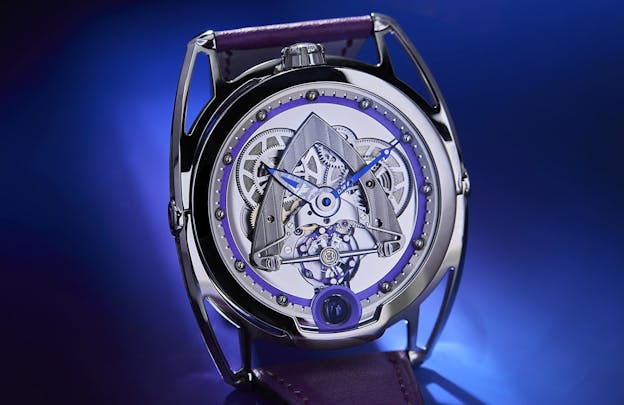A Unique Piece DB28 ‘Steel Wheels’
A very special version of one of De Bethune’s most visually compelling watches.
There is to put it mildly, nothing like a “standard” De Bethune watch; the company makes just a small number of watches per year and De Bethune’s design language and technical capabilities have evolved so dynamically that it’s hard to find any one watch that looks like another (check out the De Bethune Heritage Collection for a bird’s eye view of some of DB’s more important design and technical milestones). Combine that with the fact that De Bethune can offer an almost unlimited degree of customization and you have the ability to own not only a very dare-to-be-different watch, but one that’s also unique in the literal sense of the word, even within the world of De Bethune.
Today we have something that shows some of the potential of De Bethune’s designs – this is a unique piece DB28 Steel Wheels.

The watch has many if not most of the technical and design features that make a DB watch instantly recognizable. The articulated floating lugs allow the watch to comfortably conform to the wrist and the crown at 12:00 is a shout-out to the pocket watch era of mechanical horology; it’s also necessitated by the overall configuration in the movement, which is rotated 90º to the left in order to bring the apex of the delta-shaped bridge to the 12:00 position. (The delta bridge was first used by De Bethune in its first in-house movement for the DB15 Perpetual Calendar in 2004 with the tip of the delta oriented towards 3:00 on the case, where the crown was located; the crown at 12:00 configuration was first adopted by De Bethune for the DBS, in 2005). The chapter ring and ring around the spherical moonphase display are done in heat colored titanium, tempered to a deep purple.

The hands are very elaborate pieces of work – they’re transparent sapphire, to provide an unobstructed view (or as unobstructed a view as possible, consistent with legibility) of the movement itself. The Steel Wheels are the ratchet wheels on the two openworked mainspring barrels, with the mainsprings themselves visible under the covers.

The delta bridge itself is decorated with DB’s signature “Côtes de Bethune” which have a symmetrical slant along the vertical axis of the bridge.

De Bethune has introduced a number of different balances over the years and in this case we have one made of heat-tempered titanium with white gold peripheral weights – these are not there to regulate timing, but rather to ensure that as much of the mass of the balance as possible is on the periphery where it should be to give the balance an optimum moment of rotational inertia. While DB had used silicon in the past, titanium in this case was chosen for its suitability for press-fitting the white gold weights in place.
The watch also uses De Bethune’s patented triple pare-chute antishock system, with anti-shock arms on either side of the balance to support the more conventional antishock system on the balance pivots themselves, and the balance spring has De Bethune’s patented outer terminal curve, which provides the same centering benefits of a Breguet overcoil but without the added height of the latter.
And, of course, there’s De Bethune’s spherical moonphase, which provides a more accurate representation of the phases of the Moon than conventional flat designs, which are all more or less schematic.

Since the movement is more or less inverted from its original configuration (as seen in the DB15 in 2004) the view through the caseback has fewer visual fireworks than the view on the dial side – which is a bit of a misnomer as there is no conventional dial, although there is an hour and chapter minute ring, with spherical titanium hour markers. The back of the watch does have something useful, though – a power reserve indicator, for the 144 hour power reserve.

As is the case with every De Bethune watch, this DB28 Steel Wheels is full of remarkable details and demonstrations of c0-founder Denis Flageollet’s ingenuity. Its aesthetics, though, are entirely its own.

